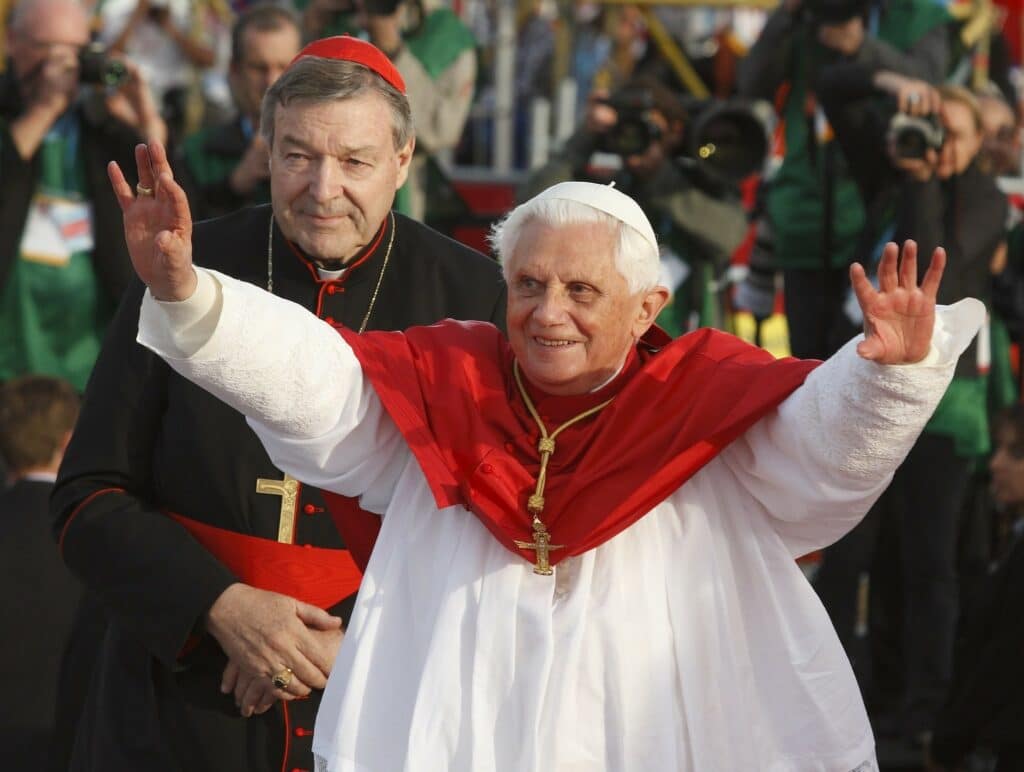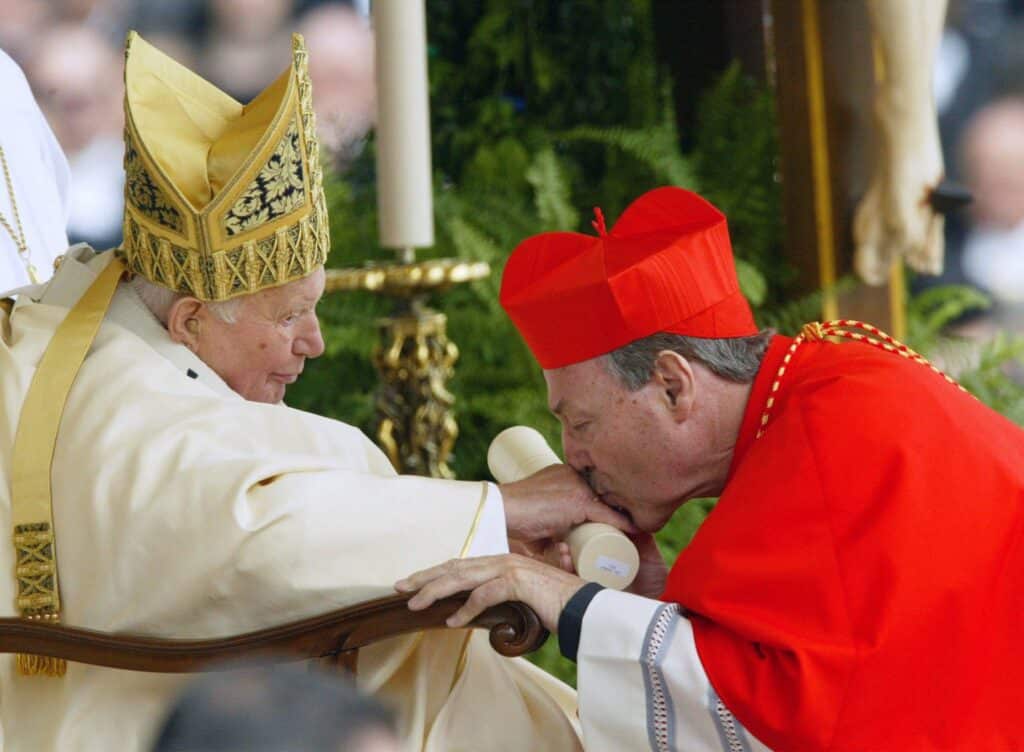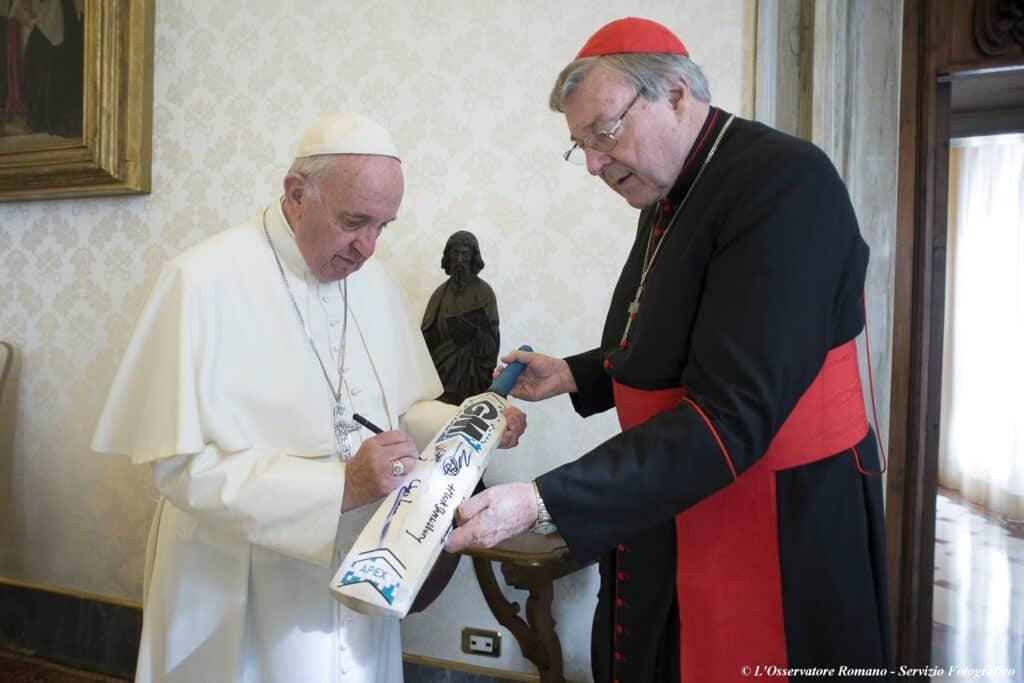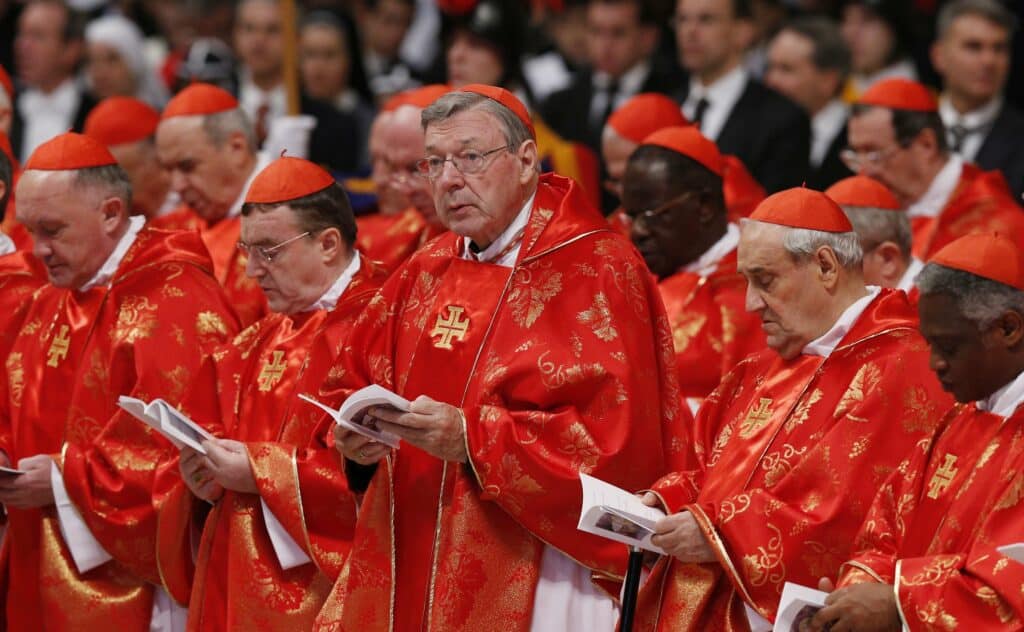
In a letter to fellow scientist Robert Hooke in 1657, Sir Isaac Newton famously said that “If I have seen further than others, it is by standing on the shoulders of giants”. With the passing of Cardinal George Pell in Rome, the church in Australia and globally bids farewell to one of its giants.
Pell’s service of the church for close on 60 years – as Archbishop of Melbourne and Sydney, as a member of the bishops’ conference for more than 25 years, as a staunch defender of the faith and public commentator, as a cardinal serving three popes and a member of national and international church bodies, and ultimately as the third-ranking churchman in the Catholic world – eclipses any other cleric in our nation’s history.
A man of immense stature and influence, his legacy will be debated and drawn upon for years to come.
As we know, giants are not simply born big – even if, like the cardinal, they are gifted with enormous physical, mental and spiritual potential. Their capacities must be cultivated and their efforts chosen.
How did a young Aussie rules player from Ballarat become the most prominent churchman in the history of Australia?
George Pell stood on the shoulders of three titans of the 20th century church: the Irish-born Archbishop of Melbourne, Daniel Mannix (1864-1963), the political organiser and social commentator B.A. Santamaria (1915-1998), and the saint and pope John Paul II (1920-2005). His admiration for all three was unmistakeable.
From Mannix he sourced inspiration and courage, a firm belief that the Catholic faith could overcome the staunchest opposition; that the church could flourish and make a real contribution even in the gloomiest of circumstances; and that church leaders could make a real difference.
A prelate must be a rock-solid foundation, one who “confirms the brethren”, a good shepherd in his words and deeds.
From Santamaria he was encouraged to see the gospel not as a private treasure but as something that must inform our character, community, and whole way of life. A faith not expressed in works is, as St James said, quite dead; a faith not expressed in social policy, institutions, family life and the rest is, Santamaria insisted, equally ineffectual. Pell followed Santamaria in seeking to embody Christ’s call to be “salt of the earth and light to the world”.
From the writings, example and ultimately friendship of Pope John Paul, Pell was emboldened to call out the rising anti-life, anti-truth and anti-religious tide of our age, and to stand for an intelligent and searching approach to the Catholic faith. John Paul’s first words as pope to the crowd gathered in St Peter’s Square were “Be not afraid” – oft repeated words of Jesus Christ. But he said “Don’t be afraid of Christ either. He takes nothing away, and he gives you everything. When we give ourselves to him, we receive a hundredfold in return. Yes, open, open wide the doors to Christ, and you will find true life!” Pell chose “Be not afraid” as his motto when John Paul appointed him bishop, a tribute not just to his personal courage and trust in divine providence, but also to his love for that great pontiff.

Intelligent, highly educated (he had a doctorate from Oxford) and a ravenous reader of books across a very wide range, he lectured and published widely. He had a profound respect for human reason and, like his friend Pope Benedict, regarded cynicism and relativism as poisons. He defended the faith against popular detractors, notably in a debate with the prominent atheist Richard Dawkins on the ABC.
He defended Catholic primary and secondary schools against those who sought to defund and close them. He led and reformed seminaries. He helped establish and maintain four Catholic institutions of higher learning: the Australian Catholic University (he was director of one of its predecessor colleges), the John Paul II Institute for Marriage and the Family, the University of Notre Dame Sydney campus, and Campion College. He served on state and national Catholic education bodies and on the Bishops’ Committee for Education, as a pro-chancellor of ACU and president of its members, as president of the Senate of the Catholic Theological College in Melbourne, as chancellor of the Catholic Institute of Sydney.
The cardinal’s concern for an intelligent and coherent faith was clear. But like all the post-conciliar popes he recognised that the same old arguments presented in the same language were unlikely to excite the children of modernity.
A “new evangelisation” was needed that addressed not just the converted or the unconverted, but the diverted – those who had fallen away from practice or belief – and with new language, approaches and technologies.
He established many ministries and institutions precisely to address this matter: youth ministries in Melbourne and Sydney, an early excursion into internet ministry, a pilgrim house (Domus Australia) in Rome, a retreat house (Benedict XVI Centre) in Grose Vale, a much-enlarged campus ministry for the universities (including the John Paul the Great Centre at Sydney University), a Western civilisation program for school leavers, and vocations ministries to inspire young people to dedicate their lives to God through priesthood, religious life or marriage.
I remember him asking me when I was one of his auxiliary bishops what I thought of World Youth Day. Though I hadn’t been to one myself I said I thought it was a genius pastoral strategy of Pope John Paul and I had seen first-hand the good it did many young people.
He asked how much of our patrimony and energy the church in Sydney should risk on hosting WYD. I said I thought it was worth a great deal, as we needed a next generation of faithful Catholics to hand that patrimony and energy on to. He agreed.

The next I heard about the idea he announced in a priests’ meeting that Sydney would be bidding for World Youth Day and that Bishop Fisher would be co-ordinating it! It was the biggest thing I’ll ever do. But it took the courage and big heart of this giant to dare bring the Pope and the youth of the world to this small Catholic population. World Youth Day 2008 turned out to be the largest religious gathering, indeed the largest gathering for any purpose, in the history of Australia and of Oceania. This monumental event had a transformative effect on the lives of thousands of young Australian Catholics and is still bearing fruit today.
Pell was in a sense too big for Australia alone. His voice soon resounded around the Anglophone world – he was a regular lecturer in America – and in other languages (he spoke several). He was appointed a cardinal in 2003 and to membership of Vatican bodies responsible for doctrine, worship, liturgical texts, family, justice and peace, healthcare, migration and evangelisation. And so, while many may think of him as singularly focused on doctrinal orthodoxy or, worse still, on social conservatism, this is a gross misreading of the man. He believed that doctrine was inseparable from all these other dimensions of life and culture.
In 2014, Pope Francis called him to Rome as the first Prefect of the Secretariat for the Economy, a role than many considered made him the third-highest ranking Catholic churchman. He was tasked with addressing the mismanagement and misuse of Vatican funds. A project of reform, it was met with staunch opposition and co-ordinated obstacles, but Pell’s personality and experience were more than enough to deal with the bullies and corruption. In another nod to his leadership and wise counsel, he was made a member of Pope Francis’s inner Council of Cardinal Advisers.

No account of Pell’s influence as a servant of the church is complete without reflecting on the period when his faith was surely most sorely tested and his trust in God most powerfully manifested. Following an unremittingly hostile campaign from certain sections of the media and of politics, the cardinal was charged, tried and convicted of historical child sexual abuse offences in 2018. I remember at the time some said that even if the evidence against Pell was flimsy at best, “somebody has to pay” for the church’s failures in this area, and he should be the fall guy. Only after more than 400 days in prison was that conviction overturned by unanimous judgment of the High Court of Australia and the cardinal’s innocence vindicated. Sadly, mud often sticks and many remember the false conviction rather than the exoneration.
It was in this period of his life that we witnessed the true stature of the man. Against every human impulse to being embittered, dispirited, and self-pitying, Pell offered only grace, mercy and prayer. He spoke with genuine concern for his accuser(s) and never stopped offering prayers for all survivors of abuse, praying always for those who unfairly and often viciously sought his demise.
His writings while in prison were later published in three volumes and deserve to be regarded as a spiritual classic. There we meet a man who was given the cross of immense injustice to bear, yet never lost hope, clinging unflinchingly to truth and its promise of freedom.
Last week I was in Rome representing the Australian bishops at the funeral of Pope Benedict XVI. I was able to meet the cardinal on several occasions and had two meals with him. He was in a chipper mood, full of wit and wisdom. Neither of us guessed it would be the last time we would meet in this life. But now I trust that he is meeting merrily with his friend Benedict in heaven, where we can all hope to see them again one day. In the meantime, pray for our deceased cardinal and pray that the church in Australia may increase in service of the people and witness to her Lord.
This article was originally published in The Weekend Australian on 14 January 2023.
